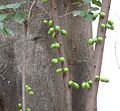Ficus polita
| Ficus polita | |
|---|---|

| |
| Specimen in Pretoria, South Africa | |
| Scientific classification | |
| Kingdom: | Plantae |
| Clade: | Tracheophytes |
| Clade: | Angiosperms |
| Clade: | Eudicots |
| Clade: | Rosids |
| Order: | Rosales |
| Family: | Moraceae |
| Genus: | Ficus |
| Species: | F. polita
|
| Binomial name | |
| Ficus polita Vahl, 1805
| |
Ficus polita, the heart-leaved fig, is a species of fig that is native to forests of tropical Africa,
Distribution[]
The tree is found in Lowland rainforest and gallery forest (west and central Africa), coastal & dry forest (east and southern African coast), and on Madagascar. It grows up to elevations of 1,200 metres (3,900 ft).[1]
Description[]
Ficus polita is similar to the Pondoland fig, (Ficus bizanae), an endemic tropical forest species in South Africa. The leaves have entire margins and are often heart-shaped, with the tip acuminate.[2]
The figs are borne on old wood, in small clusters on stumpy branchlets.[2]
The pollinating wasp is Courtella bekiliensis bekiliensis (Risbec) in Madagascar, and Courtella bekiliensis bispinosa (Wiebes) on the African mainland.[1]
Gallery[]

Bark texture 
Leaf shape 
Fig clusters 
Fig
References[]
- ^ a b van Noort, Simon; Rasplus, Jean-Yves. "Ficus polita polita Vahl 1805". Figweb. Iziko Museums. Archived from the original on 2 April 2015. Retrieved 2 March 2015.
- ^ a b Palmer, Eve (1977). A Field Guide to the Trees of Southern Africa. London, Johannesburg: Collins. p. 89. ISBN 0-620-05468-9.
External links[]
 Media related to Ficus polita at Wikimedia Commons
Media related to Ficus polita at Wikimedia Commons- Ficus polita in West African plants – A Photo Guide.
- Ficus
- Trees of Africa
- Afrotropical realm flora
- Plants described in 1805
- Taxa named by Martin Vahl



